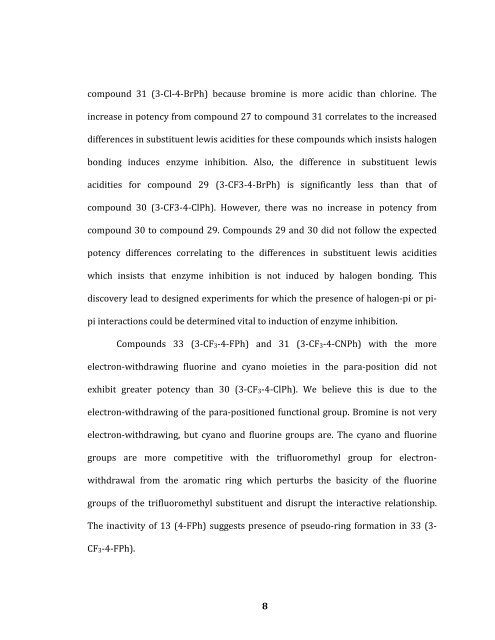Synthesis and Biological Evaluation of Phthalazinone Inhibitors of ...
Synthesis and Biological Evaluation of Phthalazinone Inhibitors of ...
Synthesis and Biological Evaluation of Phthalazinone Inhibitors of ...
You also want an ePaper? Increase the reach of your titles
YUMPU automatically turns print PDFs into web optimized ePapers that Google loves.
compound 31 (3-Cl-4-BrPh) because bromine is more acidic than chlorine. The<br />
increase in potency from compound 27 to compound 31 correlates to the increased<br />
differences in substituent lewis acidities for these compounds which insists halogen<br />
bonding induces enzyme inhibition. Also, the difference in substituent lewis<br />
acidities for compound 29 (3-CF3-4-BrPh) is significantly less than that <strong>of</strong><br />
compound 30 (3-CF3-4-ClPh). However, there was no increase in potency from<br />
compound 30 to compound 29. Compounds 29 <strong>and</strong> 30 did not follow the expected<br />
potency differences correlating to the differences in substituent lewis acidities<br />
which insists that enzyme inhibition is not induced by halogen bonding. This<br />
discovery lead to designed experiments for which the presence <strong>of</strong> halogen-pi or pipi<br />
interactions could be determined vital to induction <strong>of</strong> enzyme inhibition.<br />
Compounds 33 (3-CF3-4-FPh) <strong>and</strong> 31 (3-CF3-4-CNPh) with the more<br />
electron-withdrawing fluorine <strong>and</strong> cyano moieties in the para-position did not<br />
exhibit greater potency than 30 (3-CF3-4-ClPh). We believe this is due to the<br />
electron-withdrawing <strong>of</strong> the para-positioned functional group. Bromine is not very<br />
electron-withdrawing, but cyano <strong>and</strong> fluorine groups are. The cyano <strong>and</strong> fluorine<br />
groups are more competitive with the trifluoromethyl group for electronwithdrawal<br />
from the aromatic ring which perturbs the basicity <strong>of</strong> the fluorine<br />
groups <strong>of</strong> the trifluoromethyl substituent <strong>and</strong> disrupt the interactive relationship.<br />
The inactivity <strong>of</strong> 13 (4-FPh) suggests presence <strong>of</strong> pseudo-ring formation in 33 (3-<br />
CF3-4-FPh).<br />
8
















